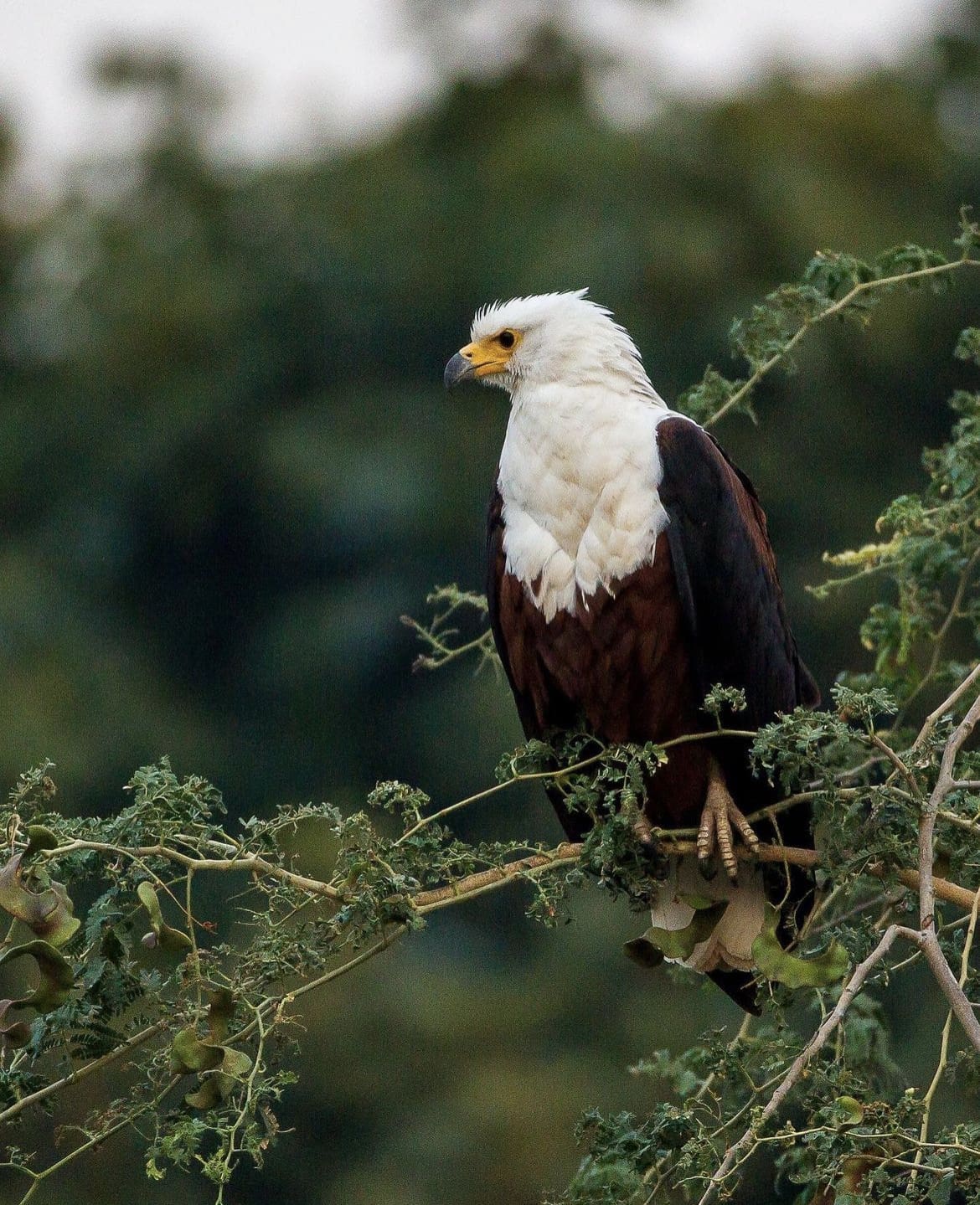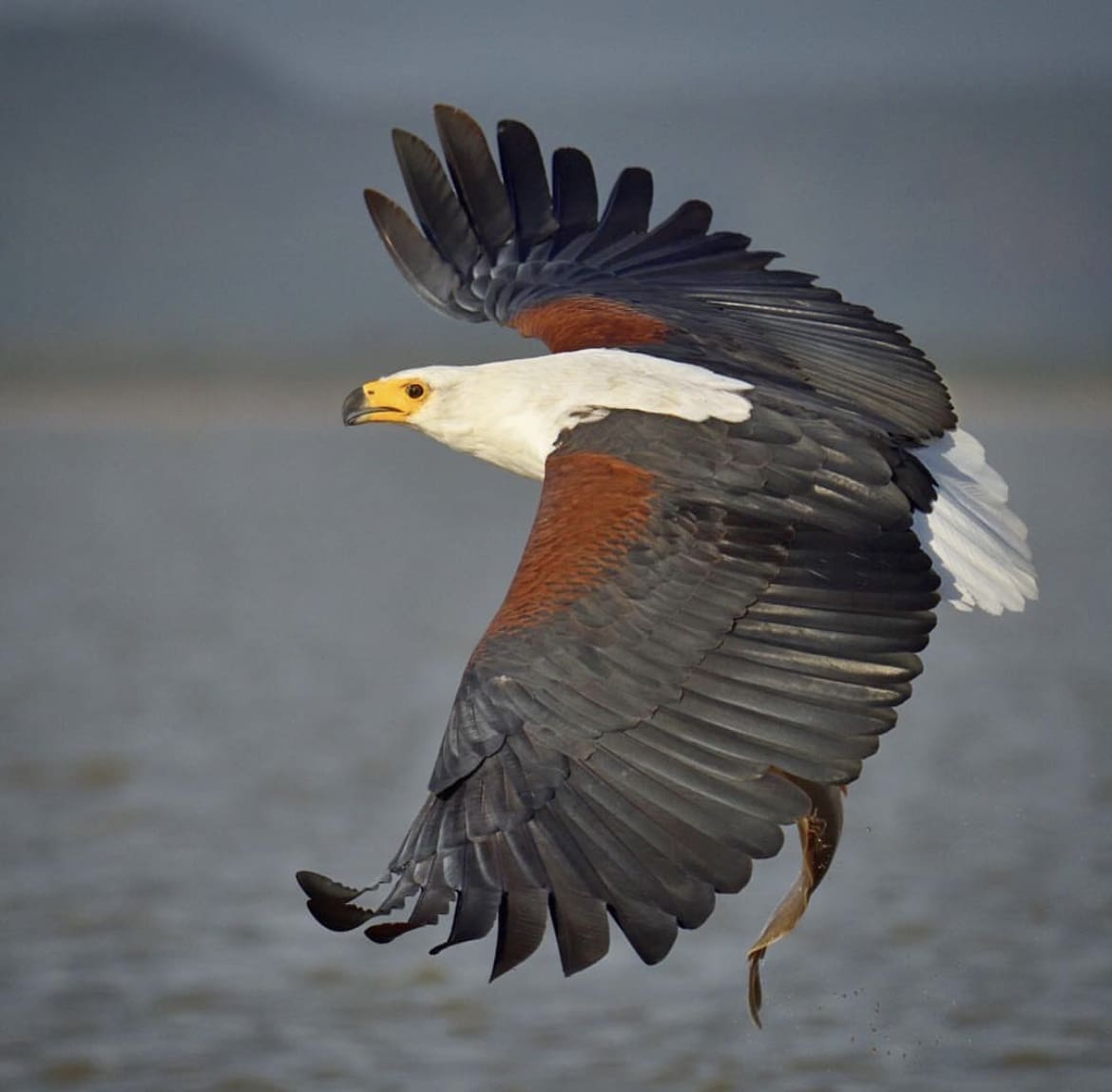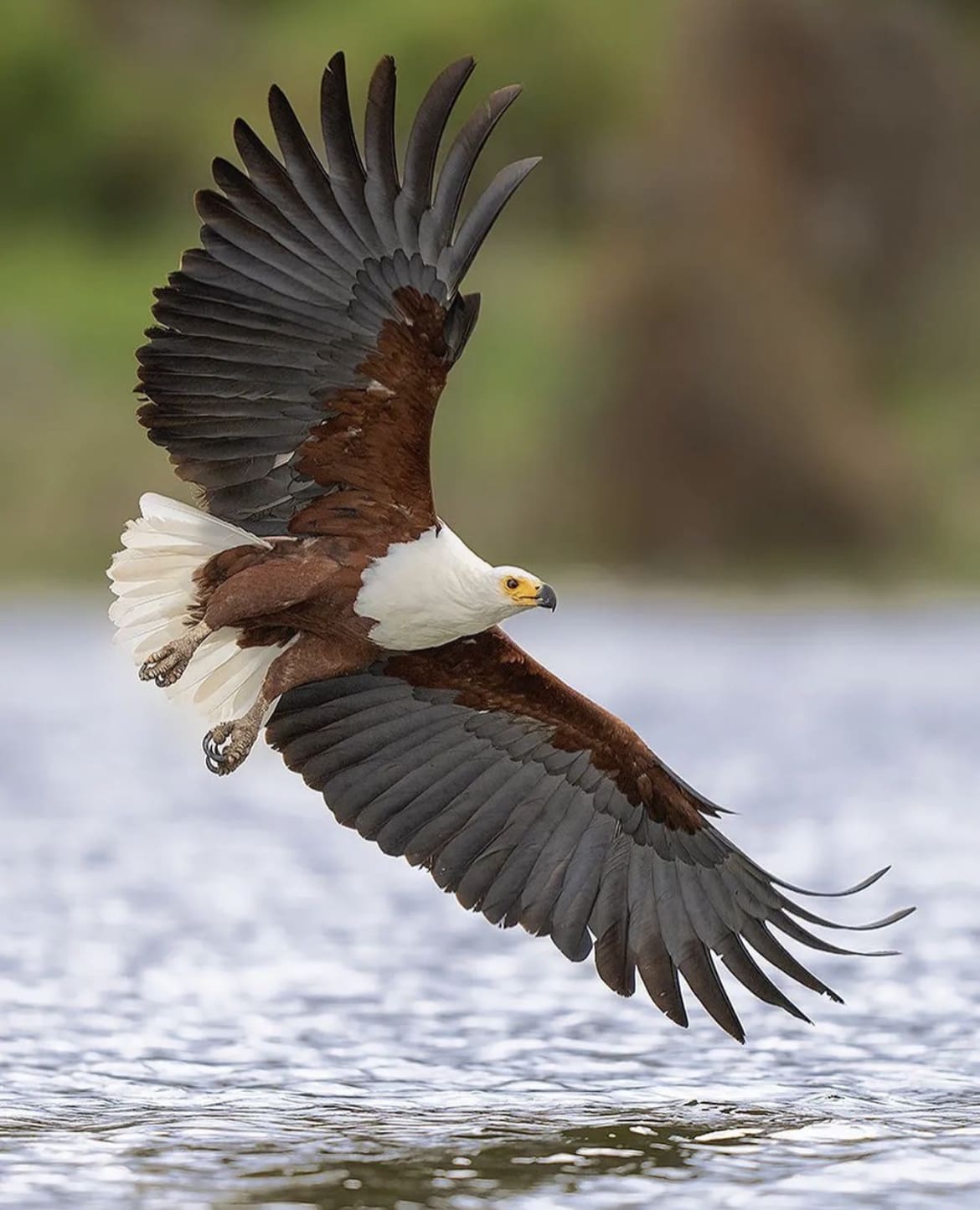The African Fish Eagle (Haliaeetus vocifer) is a bird of prey species found in sub-Saharan Africa. It is a large, with a wingspan of up to 6 feet (1.80m), and is recognizable by its distinctive white head, brown body, and sharp yellow talons.
What is the African Fish Eagle?
The African Fish Eagle is known for its powerful call, which can be heard for miles, and its habitat includes large bodies of water, such as lakes, rivers, and coastlines. The bird feeds mainly on fish, which it hunts by diving into the water from the air, using its sharp talons to grasp its prey.
This bird of prey is considered a symbol of strength, freedom, and independence in many African cultures, and it is also a protected species, with efforts underway to conserve its population and habitat.

Appearance
What does the African Fish Eagle look like?
The African Fish Eagle has a distinctive appearance that makes it easily recognizable. It has a large, white head with a dark, hood-like crest, a brown body, and large, powerful wings with a wingspan of up to 6 feet.
Their legs and feet are yellow, and they possess a large bill that is hooked, perfect for grasping fish. Their eyes are dark and piercing, and set against the white head, giving the bird a striking, fierce look.
Overall, its distinctive appearance and powerful presence make the African Fish Eagle one of the most iconic birds in Africa.
How big is the African Fish Eagle?
The African Fish Eagle is a large bird, measuring up to 2 feet in height, with a body weight of around 5-7 pounds (2-4kg). The wingspan of the African Fish Eagle can reach up to 6 feet, making it one of the larger birds of prey in Africa.
Despite its size, the African Fish Eagle is agile and powerful in flight, capable of diving into the water to catch fish with remarkable speed and accuracy.

African Fish Eagle Talons
The African Fish Eagle has large, powerful talons that are essential to its hunting and survival. These talons are sharp and yellow, and are used to grasp and hold its prey, especially fish, which make up the majority of its diet. The African Fish Eagle is known for its impressive diving abilities, and its talons play a key role in this. When diving into the water, the bird tucks its wings and extends its talons to grab fish swimming near the surface.
The African Fish Eagle’s talons are also used for defence, both against predators and to protect its territory. The sharp claws allow the bird to fend off other animals, and the bird will use them to defend its nest and young from intruders. The strength and dexterity of the African Fish Eagle’s talons are a testament to its powerful and adaptable biology, and they play a crucial role in the bird’s success in the African wilderness.
Behaviour
African Fish Eagle Social Structure
African Fish Eagles have long been portrayed as solitary birds, and they are known for their strong territorial instincts. However, African Fish Eagles mate for life, and pairs may remain together for many years. Each bird establishes a territory around its nest and will defend it fiercely against intruders.
African Fish Eagles are highly vocal birds, and they use a variety of calls to communicate with each other. The bird’s distinctive call, which is often described as a “kee-yah” or “kweek” sound, is easily recognizable and is used to signal a range of emotions, from excitement to aggression. The call of the African Fish Eagle is also used to signal to potential mates and to warn other birds to stay away from their territory.
Despite their semi-solitary nature, African Fish Eagles play an important role in their ecosystem, serving as a key predator and helping to maintain a balanced food chain.

How do African fish eagles reproduce?
African Fish Eagles breed seasonally, typically during the wetter months of the year. During the breeding season, the male and female work together to build a large nest, which may be constructed of sticks, reeds, and other materials, and is typically located near a body of water.
Once the nest is built, the female will lay a clutch of 1 to 3 eggs, which are incubated by both the male and female for approximately 45 days. Once the eggs hatch, the male and female take turns caring for the young, bringing food to the nest and protecting the chicks from danger. The young eagles fledge the nest after about 3 months, but they continue to rely on their parents for food and protection for several more months.
African Fish Eagles typically breed once a year, but they may produce multiple clutches if the first one fails. The breeding cycle of the African Fish Eagle is an important part of its biology, and it plays a critical role in maintaining the bird’s population and ensuring its continued survival.
What do African fish eagles eat?
African Fish Eagles feed primarily on fish, which they hunt from the air. They have keen eyesight and are able to spot fish swimming near the surface from high in the sky. When they spot a fish, they will dive down to the water and use their sharp talons to grasp the fish and carry it back to their perch.
In addition to fish, African Fish Eagles may also feed on other aquatic animals, such as reptiles, amphibians, and crustaceans. The bird will also occasionally feed on birds and mammals, such as waterfowl and very young antelopes, but fish make up the majority of its diet.
African Fish Eagles are opportunistic hunters, and they will take advantage of any available food source in their territory. They are highly adaptable, and they are able to hunt in a variety of habitats, from large rivers and lakes to small streams and ponds. The African Fish Eagle’s hunting success is essential to its survival, and its ability to feed on a wide range of prey allows it to thrive in the African wilderness.

How do African fish eagles hunt?
African Fish Eagles hunt primarily by diving down to the water’s surface to capture fish. They have keen eyesight and are able to spot fish swimming near the surface from high in the air. When they spot a fish, they will fly down and extend their sharp talons to grasp the fish and carry it back to their perch.
The African Fish Eagle is a highly skilled hunter, and it has several adaptations that help it to be successful in capturing fish. The bird’s large size and powerful wingspan allow it to cover large areas of water in a single dive, and its sharp talons make it possible for it to grasp fish and carry them to its perch. The bird’s keen eyesight and ability to fly at high speeds also give it a significant advantage over other birds of prey in the area.
African Fish Eagles typically hunt alone, but they may also hunt in pairs or in small groups during times of abundant food. They are highly adaptable, and they are able to hunt in a variety of habitats, from large rivers and lakes to small streams and ponds.
Range and Habitat
Where do African fish eagles live?
African Fish Eagles are found throughout sub-Saharan Africa, from the Senegal River in the west to the Zambezi River in the east. They are primarily associated with large bodies of water, such as lakes, rivers, and coastal areas, and they are highly dependent on these environments for their survival.
African Fish Eagles are opportunistic birds, and they are able to thrive in a variety of habitats, from mangrove swamps and lagoons to large dams and reservoirs. The bird’s large size and powerful wingspan allow it to cover large areas of water in search of food, and its sharp talons make it possible for it to grasp fish and carry them to its perch.

Conservation
Are African fish eagles endangered?
African Fish Eagles are not considered endangered, but they are listed as a species of Least Concern by the IUCN Red List of Threatened Species. However, the population of African Fish Eagles has declined in some areas due to habitat loss, pollution, and other environmental factors.
African Fish Eagles are protected by law in many countries, and conservation efforts are underway to protect their habitats and ensure the survival of the species for future generations. These efforts include the protection of wetlands and other aquatic environments, the control of pollution, and the management of human activities that may impact the birds or their habitats.
How many African fish eagles are left in the wild?
The exact number of African Fish Eagles is difficult to determine, as the species is widespread and found in many different habitats across sub-Saharan Africa. The species is listed as Least Concern by the IUCN Red List of Threatened Species, which means that it is considered to have a stable population and is not currently at risk of extinction.
However, African Fish Eagles have faced declining populations in some areas due to habitat loss, pollution, and other environmental factors. Conservation efforts are underway to protect the species and its habitats, and to promote the survival of the species for future generations.
Despite these challenges, African Fish Eagles remain one of the most widespread and abundant birds of prey in Africa, and their populations are considered to be relatively stable overall. Their hunting success and adaptability allow them to thrive in a variety of habitats, and they continue to play a critical role in maintaining a balanced food chain and promoting biodiversity in the African wilderness.

Threats to the African fish Eagle species
In recent years, African Fish Eagles have faced a number of threats to their habitat, including pollution, deforestation, and the destruction of wetlands and other aquatic environments. Despite these challenges, African Fish Eagles continue to thrive in many parts of Africa, and they remain an iconic symbol of the African wilderness.
African Fish Eagles face several threats to their survival, including:
- Habitat loss and degradation: The loss of wetlands and other aquatic environments due to deforestation, urbanization, and other forms of habitat destruction is a significant threat to African Fish Eagles. This can limit the availability of food and nesting sites, and may lead to declining populations of the species.
- Pollution: Contamination of rivers, lakes, and other aquatic environments by pollutants, such as oil spills, chemical waste, and sewage, can harm African Fish Eagles and their prey. This can impact the health and reproduction of the birds, and may lead to declines in their populations.
- Human activities: Human activities, such as fishing and hunting, can impact African Fish Eagles and their habitats. Overfishing can reduce the availability of food for the birds, while hunting and poaching can harm the populations of fish and other aquatic species that are critical to the survival of the African Fish Eagle.
- Climate change: Climate change is likely to have a major impact on African Fish Eagles and their habitats. Changes in temperature and precipitation patterns, rising sea levels, and increased frequency of extreme weather events can all have negative impacts on the species and its habitats.
Conservation efforts are underway to address these threats and protect the African Fish Eagle and its habitats. These efforts include the protection of wetlands and other aquatic environments, the control of pollution, the management of human activities that may impact the birds or their habitats, and the promotion of sustainable use of natural resources.
Safari
Where can I see African fish eagles on safari?
African Fish Eagles can be seen in many different parts of sub-Saharan Africa, and are a common sight along the continent’s major rivers and lakes. Some of the best places to see African Fish Eagles on safari include:
- The Okavango Delta, Botswana: This vast wetland is home to a rich diversity of wildlife, including African Fish Eagles, and is considered one of the best places in Africa to see the species.
- The Maasai Mara, Kenya: The Maasai Mara is one of Kenya’s most famous wildlife reserves, and is known for its abundant bird life, including African Fish Eagles.
- The Zambezi River, Zambia and Zimbabwe: The Zambezi River is home to a rich variety of wildlife, including African Fish Eagles, and is considered one of the best places in Africa to see the species.
- Lake Victoria, Tanzania and Kenya: Lake Victoria is the largest lake in Africa and is home to a rich diversity of fish and other aquatic species, making it a prime habitat for African Fish Eagles.
- The Kruger National Park, South Africa: The Kruger National Park is one of South Africa’s most famous wildlife reserves and is home to a rich diversity of wildlife, including African Fish Eagles.
These are just a few examples of the many places in Africa where African Fish Eagles can be seen on safari. When planning a safari, it’s always best to consult with a local tour operator or travel agent to find the best places to see African Fish Eagles, based on your specific interests and travel plans.

Tips for spotting African Fish Eagles in the wild
- Look for them near water: African Fish Eagles are primarily found near water, such as rivers, lakes, and wetlands, so these are good places to start your search.
- Look for their distinctive call: African Fish Eagles have a distinctive, high-pitched call that is easily recognizable. Listen for their call and keep an eye out for birds in the sky.
- Look for them near fishing boats: African Fish Eagles are opportunistic hunters and are often attracted to fishing boats, where they can steal fish from the lines. Look for birds soaring near fishing boats or diving into the water to steal fish.
- Watch for them while on a boat safari: Taking a boat safari is a great way to see African Fish Eagles, as the birds are often visible from the water. Keep an eye out for birds diving into the water or soaring overhead.
- Look for them near nests: African Fish Eagles often build large, conspicuous nests near the water, so keep an eye out for these structures when searching for the birds.
- Be patient: African Fish Eagles can be elusive and may take some time to spot, so be patient and keep a keen eye out for the birds.
By following these tips and working with a knowledgeable guide, you can increase your chances of spotting African Fish Eagles in the wild and experiencing the incredible beauty of these magnificent birds in their natural habitats.
Facts about the African fish Eagle
- National symbol: The African Fish Eagle is widely regarded as the national symbol of Zimbabwe, appearing on the country’s flag and currency.
- Strong wingspan: African Fish Eagles have a wingspan that can reach up to 6 feet, allowing them to soar over vast distances in search of food.
- Exceptional vision: African Fish Eagles have exceptional vision, with eyes that are nearly as large as those of humans. This allows them to spot prey from great distances, even while flying at high altitudes.
- Loud call: The African Fish Eagle has a loud, high-pitched call that can be heard for miles. This distinctive call is often used to mark territory and to attract mates.
- High degree of adaptability: African Fish Eagles are highly adaptable birds and are able to thrive in a wide range of environments, from desert regions to tropical rainforests.
- Versatile hunters: African Fish Eagles are versatile hunters and feed on a wide range of prey, including fish, reptiles, mammals, and birds.
- Long-lived birds: African Fish Eagles are long-lived birds, with some individuals known to live for more than 20 years in the wild.

Myths about the African fish Eagle
- Fish-eating bird: Despite its name, the African Fish Eagle is not exclusively a fish-eating bird. While fish form a significant portion of its diet, the bird is also known to feed on a wide range of prey, including reptiles, mammals, and birds.
- Aggressive predator: The African Fish Eagle is sometimes depicted as an aggressive predator that attacks other birds and animals. However, the bird is primarily a scavenger and will often feed on carrion or steal prey from other birds rather than actively hunting.
- Unlucky bird: In some African cultures, the African Fish Eagle is associated with misfortune and is considered to be an unlucky bird. However, there is no scientific evidence to support this belief, and the bird is widely regarded as a symbol of strength, freedom, and beauty.
- Solitary bird: The African Fish Eagle is sometimes portrayed as a solitary bird that prefers to live and hunt alone. However, the bird is often seen in pairs or family groups, and is known to hunt and feed together with its mate.
- Endangered species: While the African Fish Eagle is listed as a species of Least Concern by the IUCN, it is facing numerous threats in certain areas, including habitat destruction and human disturbance. However, the bird has a large and stable population, and is not considered to be a globally endangered species.
